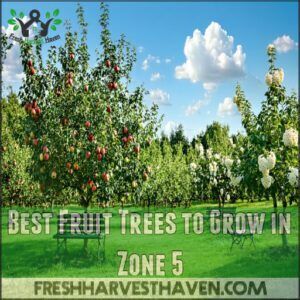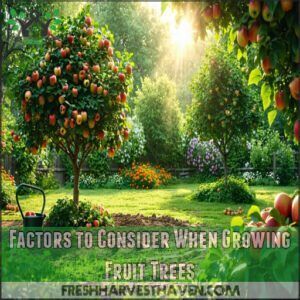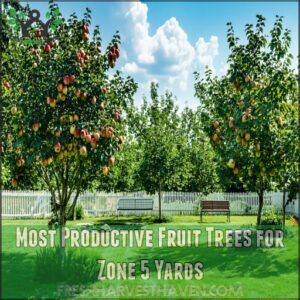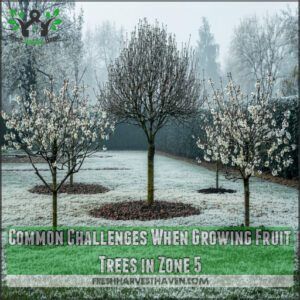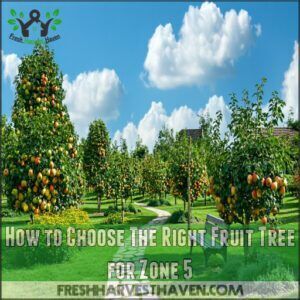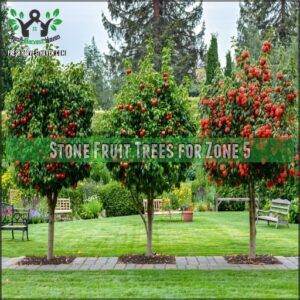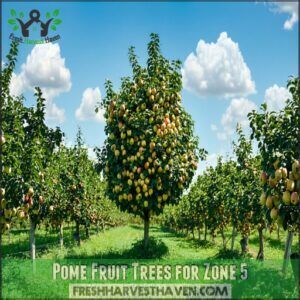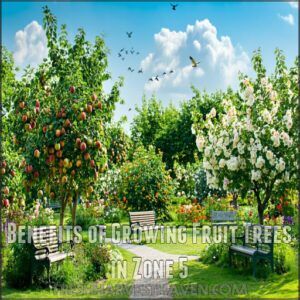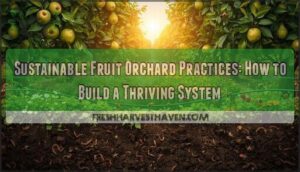This site is supported by our readers. We may earn a commission, at no cost to you, if you purchase through links.
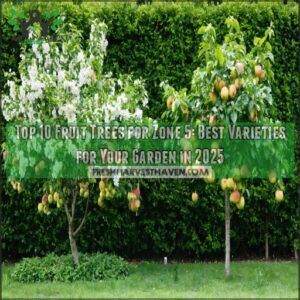
You need fruit trees that can handle the extremes, and we’ve got just the list for you.
First up are apple trees, with Honeycrisp and Gala offering that perfect crisp, sweet bite.
Pear trees like Bartlett, Kieffer, and Orient produce an early harvest, while plum trees, including Santa Rosa and Stanley, are compact and quick to fruit.
Peach trees, like July Prince, and Red Haven, need careful pest management but reward you with fast fruit production.
Finally, for something different, try fig trees—low-maintenance and deer-resistant.
Stay tuned for more in-depth insights on these top contenders and beyond!
Table Of Contents
- Key Takeaways
- Top Fruit Trees for Zone 5
- Best Fruit Trees to Grow in Zone 5
- Factors to Consider When Growing Fruit Trees
- Top 5 Easy-to-Grow Fruit Trees for Zone 5
- Most Productive Fruit Trees for Zone 5 Yards
- Common Challenges When Growing Fruit Trees in Zone 5
- How to Choose The Right Fruit Tree for Zone 5
- Fruit Trees That Thrive in Zone 5’s Climate
- Tips for Growing Fruit Trees in Zone 5
- Benefits of Growing Fruit Trees in Zone 5
- Frequently Asked Questions (FAQs)
- When should you plant fruit trees in zone 5?
- What is the lowest maintenance fruit tree?
- What fruits and vegetables grow best in zone 5?
- What is the easiest fruit tree to keep alive?
- What fruit trees grow in Zone 5?
- Which apples grow best in Zone 5?
- Which pears grow best in Zone 5?
- Can fruit trees grow in zone 5b?
- Which plum tree is best for Zone 5?
- Which fruits grow best in Zone 9?
- Conclusion
Key Takeaways
- You can grow a variety of fruit trees in Zone 5, including apple, pear, plum, peach, and fig trees.
- The best time to plant fruit trees in Zone 5 is late April to mid-May, giving them time to establish before winter.
- Fig trees are the lowest maintenance option, thriving indoors and outdoors, and resistant to deer, rabbits, and squirrels.
- Zone 5’s cold winters and short growing season mean you need to choose fruit trees that can handle frost, such as apples, pears, plums, and peaches.
Top Fruit Trees for Zone 5
If you’re planting fruit trees in Zone 5, you’ve got plenty of hardy, productive options to choose from.
From juicy apples to sweet plums, these trees can handle cold winters and reward you with fresh, delicious harvests.
Apple Trees for Zone 5
Apple trees are a must-have for Zone 5 gardeners.
These cold-hardy fruit trees thrive with minimal effort – just decent soil, full sun, and 15 feet of elbow room.
Favorites include Honeycrisp and Gala for their crisp, sweet flavors.
Ready to get started? Here are your essentials:
- Apple care tips: Regular fruit tree pruning is key.
- Zone 5 planting: Aim for spring.
- Apple pest control: Watch for deer and beetles.
- Harvest timing strategies: August to November.
Pear Trees for Zone 5
In the case of zone 5 fruit trees, pear trees are the dependable all-stars, delivering sweet, juicy fruit even in challenging conditions.
With their stunning spring blossoms and fiery fall foliage, they’re a treat for both your yard and your taste buds.
Pear trees like Bartlett, Kieffer, and Orient thrive here and grow up to an impressive 50 feet tall.
- Cold hardy favorites: Perfect for zone 5 winters.
- Early fruiting: Beat apple trees to the punch.
- Drought-resistant: Great for low-maintenance gardens.
- Visual appeal: Blossoms and gorgeous fall colors.
Plum Trees for Zone 5
Looking for a tree that pulls its weight? Zone 5 plum trees are all about sweet rewards with minimal fuss.
These compact 8-10 ft trees bring beauty, quick growth, and bountiful fruit production to small spaces. Plus, they’re champs at dodging pests and diseases.
Some top picks include Santa Rosa plums with their irresistible flavor or Stanley plums, a disease-resistant favorite.
Check out this handy table of must-try plum varieties:
| Variety | Special Features | Harvest Timing |
|---|---|---|
| Santa Rosa | Sweet flavor, 500 chill hours | Late summer |
| Stanley | Self-pollinating, disease-tough | Early fall |
| Mount Royal | Cold-hardy, compact size | Mid-summer |
| Green Gage | Rich taste, heritage pick | Late summer |
| Black Ice | Early bearer, fast-growing | Early August |
Peach Trees for Zone 5
Why not brighten your yard with peach trees for Zone 5?
Varieties like July Prince and Red Haven pair beauty with productivity, thanks to their stunning spring blossoms and fast fruit production—often within 1-2 years.
These frost-sensitive stars thrive with proper Peach Tree Care, focusing on Soil Preparation and Cold Protection, plus regular Pest Management to enjoy the best peaches for Zone 5.
Fig Trees for Zone 5
Fig trees may surprise you in Zone 5, offering unique rewards without the usual hassle of cold hardy fruit trees.
These low-maintenance beauties thrive indoors or out, dodging pests like deer and rabbits.
To keep them happy, stick to proper pruning and protect them during chilly spells.
With a little care and attention, you’ll enjoy ample fruit production—perfect for anyone exploring the best fruit trees for Zone 5, with proper pruning being key to their success.
Best Fruit Trees to Grow in Zone 5
Got space for a mini orchard? Zone 5’s cold climate fruits make it totally doable! Apple trees, like Honeycrisp, are rockstars for heavy harvests.
Pear trees, such as the Bartlett, handle frosty winters like pros. And plum trees? Compact, perfect for tight spots, and bursting with juicy rewards.
Here’s why these zone 5 fruit trees thrive:
- Apple trees grow easily with simple winter pruning.
- Pears are tough and fruit early.
- Plums stay small but produce big.
Prep your soil and enjoy backyard abundance!
Factors to Consider When Growing Fruit Trees
When you’re growing fruit trees, it’s important to think about things like sunlight, soil, and how cold it gets in your area.
Skipping these basics can leave you with trees that look great but don’t produce much fruit!
Soil and Sun Requirements
Now that you’ve picked your favorite fruit trees, let’s nail down what they need to thrive.
Perfect soil and sun exposure make all the difference between a bumper crop and disappointment.
Here’s the scoop: your trees want loamy soil that drains well, with a soil pH level between 6.0 and 7.0.
Think of it like making the perfect bed – not too hard, not too soft, just right.
Check your soil type and drainage systems before planting.
For sun exposure, aim for a spot that gets at least 6-8 hours of direct sunlight daily.
It’s like finding the perfect tanning spot, but for your trees.
And remember – good nutrient balance keeps your trees happy.
If you’re dealing with clay soil, mix in organic matter to improve drainage and support those roots.
To guarantee the best results, consider zone 5 planting guidelines for your specific tree varieties.
Cold Hardiness and Chill Hours
Just as bears need their winter rest, your cold hardy fruits need the right amount of chilly downtime to thrive in Zone 5.
These hardy varieties require specific chill requirements – time spent between 32-45°F – to wake up properly in spring.
Most Zone 5 fruit trees need 800-1000 hours of cold, but it varies.
Knowing your tree’s frost tolerance helps prevent those heartbreaking moments when late frosts zap your budding blossoms.
Smart winter protection starts with picking the right variety.
Understanding chill hour maps is vital for selecting the most suitable tree varieties for your garden.
Pollination and Spacing Needs
Like dance partners at a garden party, your fruit trees need the right spacing and companions for a successful harvest.
For ideal cross-pollination and fruit set, plant compatible varieties within 50-100 feet of each other.
Your tree spacing guide: dwarf varieties need 8-12 feet, while standard trees require 15-20 feet between neighbors.
Here’s a pro tip: plant one crabapple for every nine apple trees to boost pollen transfer .
Remember, even self-fertile varieties like ‘Victoria’ plums produce better when they’ve got friends nearby.
Pest and Disease Resistance
While proper spacing sets the foundation, your fruit trees need smart defenses against unwanted visitors.
Some varieties come with built-in protection – figs naturally resist deer and rabbits, while many plum varieties shrug off common pests and diseases.
Try companion planting with aromatic herbs for extra pest control, and keep those branches pruned for good airflow to prevent fungal problems.
Remember: well-cared-for trees fight off disease better than stressed ones, which is why smart defenses and good airflow are crucial.
Top 5 Easy-to-Grow Fruit Trees for Zone 5
You can grow amazing fruit in Zone 5 without becoming a gardening guru.
These easy-care fruit trees survive cold winters and practically look after themselves.
When selecting trees, consider the best fruit trees for your specific needs.
Your top options for hassle-free Zone 5 gardening include:
- Apple trees take the crown for easy fruit tree care, thriving in most soils with minimal fuss
- Plum trees stand strong against pests while staying compact – perfect for smaller spaces
- Fig trees naturally resist deer and rabbits, making your garden care routine a breeze
Want stress-free success with fruit trees that survive zone 5?
Choose dwarf varieties for patios and small yards – they’ll reward you with the same delicious harvests in a manageable size.
Most Productive Fruit Trees for Zone 5 Yards
You’ll be amazed at how productive your Zone 5 yard can become with the right fruit trees, from sweet-tasting Honeycrisp apples to juicy Bartlett pears.
Whether you’re planning to feed your family or share with neighbors, these proven varieties can produce hundreds of pounds of fresh fruit each season with proper care.
Apple Tree Varieties for Zone 5
Want cold hardy fruit trees that’ll reward you year after year?
Zone 5 apple cultivation stars include Honeycrisp, thriving in chilly winters with crisp, sweet harvests, Akane packs intense flavor in a compact size, while Ashmead’s Kernel offers exceptional taste despite its rustic looks.
For reliable fruit selection, McIntosh delivers consistent September harvests.
Understanding top fruit varieties is vital for a successful harvest.
Plant two compatible varieties for ideal pollination – your future apple pies will thank you.
Pear Tree Varieties for Zone 5
Looking beyond apples, pear trees excel in zone 5 gardens with remarkable hardiness and sweet rewards.
The Orient pear shines with its juicy fruit and 20-foot spread, while the rugged Kieffer pear handles zones 4-9 like a champ.
For successful fruit set, plant your Bartlett near Stark or Moonglow varieties.
These trees thrive in sunny spots with well-draining soil, delivering delicious harvests from late August through October.
Plum Tree Varieties for Zone 5
Several zone 5 plum trees deliver impressive fruit yields, with Santa Rosa leading the pack.
You’ll get plenty of sweet, juicy plums from these compact trees that top out at 8-10 feet – ideal for tighter spaces.
They’re quick growers and handle summer heat like champs.
Best part? These tough cookies resist most pests and diseases that plague other fruit trees.
Just give them regular pruning in late winter, and they’ll reward you with bountiful harvests every August.
Peach Tree Varieties for Zone 5
Peach trees bring a slice of summer to Zone 5 gardens when you pick the right varieties.
These cold-hardy champs deliver sweet rewards:
- July Prince: Ripens late summer, perfect for canning and desserts.
- Red Haven: A hardy all-star, ripening early with juicy fruit.
- Contender: Compact and container-friendly, perfect for tight spots.
- Reliance: Delicious and dependable, tolerates harsh winters like a pro.
Peach tree care keeps them thriving!
Common Challenges When Growing Fruit Trees in Zone 5
Growing fruit trees in Zone 5 comes with unique challenges: cold winters, late frosts, and pests.
But don’t worry; with careful planning and the right varieties, you can enjoy a fruitful harvest and a vibrant garden.
Pests and Diseases Affecting Fruit Trees
Your fruit trees are a feast for unwanted visitors and diseases.
Apple trees, for instance, often tussle with Japanese beetles and aphids, while pear trees mostly grapple with aphid infestations.
Most stone fruits are susceptible to blight and mold.
Then there are critters like deer, rabbits, and squirrels, keen for a taste of your harvest.
But don’t fret—creating a balanced ecosystem with companion planting and adopting organic pest control methods will keep these issues at bay.
Vigilant monitoring is key to staying ahead of these threats and ensuring your trees stay healthy and happy.
Weather Conditions Affecting Fruit Trees
Weather woes got you worried? Zone 5’s climate can throw some curveballs, but you can keep your fruit trees thriving with a few smart moves.
- Late Spring Freeze: A sneaky spring freeze can wreck tender blossoms, especially on peach and apricot trees.
- Temperature Swings: Wild winter temp swings might cause bark splitting and branch damage. A thick layer of mulch around the tree’s roots helps.
- Strong Winds: Wind can knock off developing fruit and stress young trees. Smart placement and windbreaks are key.
Keep an eye on the forecast and be ready to give your trees a helping hand when Mother Nature turns tricky. It’s all part of the zone 5 gardening adventure!
Soil and Nutrient Deficiencies
Beyond battling the elements, your fruit trees face a stealthier threat: the ground they grow in.
Zone 5’s varied soil types can throw your trees for a loop, causing nutrient deficiencies that stunt their growth.
Regular soil testing shines a light on these issues, revealing low phosphorus or iron levels.
Boost your soil’s health by adding organic matter, keeping pH levels in check (6.0-7.0), and using the right fertilizers.
It’s like giving your trees a solid foundation—get it right, and they’ll thrive.
How to Choose The Right Fruit Tree for Zone 5
When choosing a fruit tree for your Zone 5 garden, it’s essential to take your space and the tree’s needs into account.
You’ll want to select a tree that fits your yard size, whether that’s a compact plum tree or a towering pear tree, and one that can withstand the cold winters and short growing season of Zone 5.
Considerations for Small Yards
Small yards, big potential.
That’s right, even compact spaces can yield bountiful harvests with the right tree choices.
Here are some space-saving strategies for your yard planning:
- Go vertical with dwarf varieties. Columnar apples, for instance, grow tall and slim, perfect for tight areas.
- Self-pollinating plum trees need just 6-8 feet of space, so they’re ideal for small yards.
- Container-friendly peach trees thrive in patio gardens, bringing beauty and fruit to your porch.
- Multi-grafted trees offer a variety of fruits on one tree, maximizing space and flavor.
When selecting trees, consider the benefits of dwarf fruit trees to make the most of your compact garden space.
Considerations for Large Yards
With a large yard, you’ve got the space to create a fruit-filled wonderland.
You can plant a variety of apples, pears, and stone fruits, ensuring proper tree spacing of 15–20 feet for their roots to roam free.
Try pairing Orient pears with Kieffer pears for cross-pollination magic, or mix Golden Delicious apples with Granny Smiths for a tasty twist.
Your yard’s size lets trees stretch their limbs and shine, making the most of the available space to grow a diverse range of stone fruits.
Considerations for Container Gardens
If you’re tight on space, container gardening is your ticket to growing fruit trees.
But it’s not as simple as plopping a tree into a pot.
To succeed with zone 5 potted fruit trees, you’ll need to master the art of container gardening.
First, snag containers measuring at least 24 inches in width and depth, equipped with drainage holes to whisk away excess water.
Dwarf varieties, like Meyer lemon trees, shine in containers.
They’re your BFFs for compact spaces.
Next up, soil mix.
Treat your containerized trees to high-quality potting soil enriched with compost.
This combo guarantees your trees get the nutrients they need to thrive.
Remember, containerized trees need extra TLC during winter.
Move them to a cozy spot or add mulch to protect them from the chill.
Fruit Trees That Thrive in Zone 5’s Climate
If you’re a gardener in Zone 5, you know the challenges of the cold winters and short growing seasons.
But don’t worry, there’s a variety of fruit trees that thrive in your climate, and we’re here to introduce you to the top 10.
Stone Fruit Trees for Zone 5
Stone fruit trees thrive in Zone 5, offering beauty and bounty.
They require specific care, like tailoring watering to weather and soil type, but reward your efforts with sweet harvests.
Here’s a trio of top picks for your garden:
- Black Tartarian Cherry: Enjoy sweet June treats and shade from this 30-foot stunner.
- Santa Rosa Plum: Reliable fruit producer with a compact 8-foot spread.
- Red Haven Peach: Manageable 15-footer serving up late July delights.
Embrace the unique joys of stone fruit care, from plum tree pruning to that first peach blossom.
Explore these and other cherry varieties for your zone, and soon you’ll be savoring the fruits of your labor.
Pome Fruit Trees for Zone 5
Zone 5’s climate is just right for pome fruits like apples and pears, which reliably bear fruit for your home orchard.
These hardy trees adapt well to local conditions and offer bountiful harvests.
Keep in mind that most pome fruits need cross-pollination, so plan for a compatible partner.
Here are some varieties to examine, along with their heights and harvest times:
| Variety | Height | Harvest Time |
|---|---|---|
| Golden Delicious | 20-25 ft | Mid-Sept to Oct |
| Bartlett Pear | 12-20 ft | Late August |
| McIntosh | 15 ft | Sept-Oct |
| Kieffer Pear | 15-20 ft | Late Sept |
Be sure to brush up on pome tree care and apple or pear cultivation tips, including tree pruning, to guarantee a healthy harvest.
Citrus Fruit Trees for Zone 5
Although citrus trees typically shy away from Zone 5’s chilly winters, you can coax them to thrive with a bit of ingenuity.
Try container gardening, bringing your citrus indoors when Jack Frost comes knocking.
Dwarf varieties like Meyer lemons, kumquats, and key limes adapt well to this nomadic lifestyle.
Just remember: bright light, humidity, and well-drained soil are non-negotiable for these sun-kissed trees.
Tips for Growing Fruit Trees in Zone 5
In regard to growing fruit trees in Zone 5, there are some key considerations to keep in mind.
You’ll need to choose the right tree varieties, plant and care for them properly, and manage pests and diseases to guarantee a healthy harvest.
Planting and Pruning Techniques
Planting and pruning are essential steps in the art of fruit tree care.
Get it right, and you’ll be harvesting juicy treats for years.
So, grab your gardening tools and let’s get started:
- Plant just above the root flare—it’s the sweet spot for healthy growth.
- Spring is the prime time for planting in Zone 5.
- Dead wood, gone. Airflow and sunlight, flowing. That’s the pruning mantra.
Keep trees tidy and productive with annual central leader and branch pruning.
Aim for a manageable 15-20 foot height—perfect for easy picking.
Proper use of Fruit Tree Pruners is vital for maintaining tree health and promoting fruit production.
Watering and Fertilizing Strategies
Watering and fertilizing are key to happy, healthy fruit trees.
Aim for 10 gallons of water per tree, once a week, during the growing season.
Start the year with a balanced 10-10-10 fertilizer in spring, then switch to phosphorus-heavy stuff when fruit starts.
A drip irrigation system saves time and guarantees consistent soil moisture.
It’s a no-brainer for water conservation and keeping your Zone 5 fruit trees well-fed and thriving.
For ideal results, consider using drip irrigation systems to maintain efficient water distribution.
Pest and Disease Management
Keeping your fruit trees healthy is a priority, so start with organic solutions like insect traps and neem oil before resorting to chemical controls.
Zone 5-specific products are also available for targeted pest control.
Keep a close eye out for Japanese beetles, aphids, and early blight symptoms with weekly check-ins.
Create natural barriers using companion plants, and make certain good air circulation through proper pruning.
For persistent problems, integrated pest management combines prevention with precise treatments.
Using a neem oil spray can be an effective method to control pests and diseases in fruit trees.
Here are some common pests and diseases to watch out for:
- Codling moths in apple and pear trees
- Western Cherry Fruit Flies in cherry trees
- Clear-winged moths, aka Greater Peachtree Borers
- Peach Twig Borers, tunneling into shoots of budding trees
Benefits of Growing Fruit Trees in Zone 5
There are so many reasons to plant fruit trees in your Zone 5 garden.
You’ll enjoy an abundance of fresh, delicious fruit, enhance your property value, and benefit the environment, too.
Plus, it’s a fun and rewarding hobby that will keep you busy and grounded.
Fresh Fruit for Your Family
Step into your backyard orchard and pick fresh, sun-kissed fruit straight from the branch – that’s the beauty of growing your own.
Zone 5’s unique climate lets you harvest a variety of crisp apples, juicy pears, and sweet plums.
You’ll know exactly how your fruit was grown, and your family can enjoy an organic, pesticide-free snack straight from nature’s pantry.
It’s a fun family affair, with kids loving to lend a hand.
Get ready to embrace fruit nutrition with the best fruit trees for Zone 5, turning your garden into a haven of fresh picks and healthy snacks.
With the right orchard care, your family harvest will be bountiful.
Understanding zone 5 gardening techniques is vital for maximizing your orchard’s potential and enjoying a successful harvest.
Increased Property Value
Well-maintained fruit trees can boost your home’s resale value—and we’re not talking chump change.
Fruit trees in your yard can increase your property’s market value by up to 20%. That’s some serious fruit-ful gains!
But it’s not just about the dollars; it’s the curb appeal:
- Landscaping Benefits: Fruit trees create stunning focal points and add year-round interest with blossoms and foliage.
- Home Resale: They offer instant curb appeal and a unique selling point for potential buyers.
- Yard Aesthetics: Transform your yard into an eye-catching oasis.
- Neighborhood Appeal: Your home will stand out from the block.
Environmental Benefits
Fruit trees are eco-warriors, championing carbon sequestration by pulling CO2 from the atmosphere and storing it.
Zone 5 fruit trees are cold-hardy, offering an eco-friendly way to boost sustainability.
Your backyard orchard, a mini-ecosystem, attracts bees and butterflies, aiding biodiversity.
The deep roots of these trees are nature’s way of improving soil health, preventing erosion, and managing water conservation.
| Benefit | Explanation | Keyword |
|---|---|---|
| Carbon Sequestration | Fruit trees absorb CO2, reducing greenhouse gases. | Carbon Sequestration |
| Air Purification | Trees absorb pollutants, improving air quality. | Air Purification |
| Soil Erosion Control | Deep roots hold soil, reducing erosion. | Soil Erosion |
| Biodiversity Conservation | Attracting pollinators increases biodiversity. | Biodiversity |
Frequently Asked Questions (FAQs)
When should you plant fruit trees in zone 5?
The ideal time to plant fruit trees in Zone 5 is late April to mid-May.
This timeframe gives your trees a chance to establish themselves before the cold hits, setting them up for success.
What is the lowest maintenance fruit tree?
Fig trees are the lowest-maintenance option for Zone They thrive indoors and out, are deer, rabbit, and squirrel-resistant, and need little care beyond protection from cold snaps and smart pruning.
What fruits and vegetables grow best in zone 5?
Zone 5’s cold winters and short growing seasons call for hardy fruits and veggies.
Think apples, pears, plums, and peaches.
Veggies-wise, go for beans, peas, and squash.
Frost-tolerant and adaptable crops are key.
What is the easiest fruit tree to keep alive?
You want a fruit tree that’s a breeze to care for?
Go for a fig tree.
They’re low-maintenance, deer and rabbit-resistant, and thrive indoors and out.
Just remember to give ’em a little TLC during cold snaps.
What fruit trees grow in Zone 5?
Zone 5’s cold winters and short growing seasons call for hardy fruit trees.
You can grow apple, pear, plum, peach, and fig trees.
Each has unique needs, but all demand frost tolerance and careful variety selection.
Which apples grow best in Zone 5?
Honeycrisp and Gala apples thrive in Zone They’re easy to care for, but keep an eye out for deer, rabbits, and beetles. Golden Delicious, Fuji, and McIntosh also do well.
Which pears grow best in Zone 5?
While apples get all the hype, don’t sleep on pears. ‘Bartlett’ and ‘Anjou’ are pear varieties that thrive in Zone 5, bringing sweet, juicy goodness your way.
Can fruit trees grow in zone 5b?
Yes, they sure can! Zone 5’s cold winters and short growing seasons mean you need to pick fruit trees that can handle frost. Think apples, pears, plums, and peaches.
Which plum tree is best for Zone 5?
For plum perfection in Zone 5, go for ‘Santa Rosa’, ‘Stanley’, or ‘Mount Royal’. These varieties are reliable, quick-growing, and pest-resistant, giving you a bountiful harvest from late summer onwards.
Which fruits grow best in Zone 9?
Zone 9’s mild winters and long growing season are a dream for tropical fruits.
Mango, avocado, and citrus trees thrive, giving you a taste of the tropics with juicy harvests to enjoy.
Conclusion
So, which fruit trees will you be planting in your Zone 5 garden this year?
Whether you’re after a crisp apple, juicy pear, or something more exotic like figs, this list has you covered.
Now you know the top 10 fruit trees for Zone 5, you can get growing and enjoy the fruits of your labor—literally!
- https://www.reddit.com/r/BackyardOrchard/comments/cldccm/best_fruit_trees_to_plant_in_zone_5a5b/
- https://onlineorchards.com/collections/self-pollinating-fruit-trees/cold-hardiness-zone-5
- https://www.gurneys.com/collections/fruits-zone5
- https://www.wilsonbrosgardens.com/fruit-plants-and-trees-for-usda-zone-5.html
- https://www.srcity.org/


